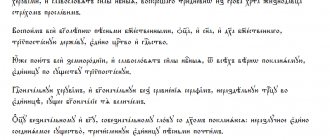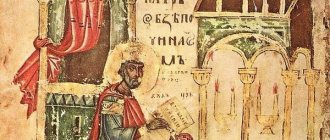Manuscript tradition
"The Shepherd" was written in Greek. Three Greek versions of the text have survived to this day.
- The Michigan Codex, created in the 3rd century, contains 20 small fragments of manuscript text. It is the most complete version of the original work.
- Codex Sinaiticus is one of the oldest versions of the Holy Scriptures, of which “The Shepherd” was a part. The document contains text ending with the 4 commandments.
- The Athos manuscript, found in the monastery of St. Gregory on Athos, dates back to the 14th-15th centuries. Contains the most complete text of the essay. The story ends with text 9 Similarities.
The book "The Shepherd" of Hermas was written about 2000 years ago
Handwritten codes have also been preserved in the following languages:
- Ethiopian;
- Latin;
- Coptic
The full text of the work has been preserved in 2 Latin translations:
- Palatina, consisting of two manuscripts, which were compiled in 150 and 486;
- Vulgata, the first manuscript version of which was compiled in 200.
The surviving Ethiopian manuscripts contain many quite significant abbreviations. The earliest surviving manuscript version in Ethiopian was discovered in the 16th century. At the end of the 20th century, a handwritten version of “The Shepherd” was discovered, dating back to the 6th century.
Authorship
Clement of Alexandria, Origen, Eusebius, and after them most of the newest scientists attribute authorship to a Roman Christian of the end of the century. Hermas, mentioned by the Apostle Paul in his letter to the Romans (XVI, 14).
Some consider this Hermas to be one and the same person as Hermas, one of the seventy apostles; but in view of the fact that the Apostle Hermas was a bishop in Philippopolis, it seems likely that the person mentioned in the Epistle to the Romans - the author of the "Shepherd" - was another Hermas, tortured in Rome by the pagan mob at the very beginning of the century.
There is an opinion that the author of “The Shepherd” was not Hermas, a disciple of the Apostle Paul, but the brother of the Roman Bishop Pius I, Hermias, who lived later (about 142-157). Others think that Hermias only translated “The Shepherd” from Greek into Latin or “reworked and supplemented” the creation of Hermas.
Editions
The first printed version of The Shepherd was published in 1513 by the French publisher Lefebvre d'Etaples. It was created based on the Vulgata manuscript.
In the middle of the 19th century, a publication was published, partially based on the Athos manuscript. It was discovered by the French forger K. Simonidis, who stole 3 of the 9 sheets of the original manuscript and copied the rest, making a large number of inaccuracies.
In 1856, the Frenchman sold the originals and the rewritten part to the University of Leipzig. At the same time, Simonidis corrected the unsuccessfully copied part from Latin manuscripts and other sources. In this form, the text of “The Shepherd” was published by R. Anger, who, after the arrest of Simonides, published an expanded edition. It was based on a copy taken by a forger from the Athos Codex.
Interesting! To date, the 1998 edition, edited by M. Leusch, enjoys the greatest authority. However, it does not take into account those discovered at the end of the 20th century. surviving pages of the Codex Sinaiticus and the second version of the Ethiopic manuscript.
The ancient text was first published in Russian in 1861. Archpriest Peter Preobrazhensky prepared a translation based on Latin manuscripts, checking them with the Athos Codex. Subsequent books in Russian were reprints of Preobrazhensky's work. In this regard, they contain quite significant inaccuracies, since the original source does not take into account manuscripts discovered in the 20th century.
Content
“The Shepherd” consists of 3 three books.
Part One - Visions
The first book consists of four visions. Like many apostolic works, it is filled with metaphors and personifications. The first vision exposes the sinful thoughts that possess many Roman residents.
In the second vision, the author appears to an elderly woman holding a book. But the man did not understand what he read until he devoted himself to fifteen days of strict fasting and persistent prayer. After 15 days, an angel appeared to Herma and announced that the woman was the Church, which was created before the creation of the world.
Saint Hermos is one of the 70 apostles
In the third vision, the man witnessed the construction of a high tower. It was built from large white stones, which six beautiful young men took out of the water and earth. Bricks raised from the water were placed at the base of the tower. They were the personification of the righteous who had undergone the rite of baptism.
The stones taken out of the ground were carefully selected. Some of them were placed in the walls of the building, others were thrown far away, and still others, rough blocks, were placed near the tower. The elderly woman explained to Herma that the stones represent humanity: the white flat monoliths are the apostles, bishops and other clergy, the other cobblestones are various groups of Christians.
Interesting! Around the building stood 7 women who personified the main Christian virtues. The interlocutor pointed out to Erma that while the building is being erected, people have a chance of salvation. But as soon as the last stone is placed in the tower, the End of the World will come, and the Judgment of God will be accomplished.
In the fourth vision, a terrible beast appeared before Herma, from whose mouth fiery locusts were bursting out. The monster's head was painted black, scarlet, gold and white. Passing by him, the man saw a young maiden in white clothes. She personified the Church.
And the beast was an image of upcoming trials. Black wool symbolizes peace; scarlet color means his death in fire and blood; gold stripes indicate Christians being tested and purified by the Lord; the white part of the body foreshadows the future in which pious Christians will find eternal life.
Part two - Commandments
The second part of the book begins with the fifth Vision, in which a man in shepherd’s clothing comes to the author. Under this simple appearance hid an angel of repentance, who ordered Herma to write down and constantly read the commandments, which set out the moral foundations of Christian teaching.
The Book of Hermas was originally included in the Bible
The angel dictated 12 short theses with the following content:
- God is the one and all-encompassing Absolute. It cannot be described in words and cannot be comprehended by the minds of people.
- A person should lead a simple life, avoid sinful actions and thoughts, and also provide help to people in need.
- The lies spoken by a person alienate him from the Lord.
- Spouses must maintain chastity in marriage. In this case, the man must accept a repentant wife who has committed adultery once. After the death of one spouse, the remaining half are allowed to remarry. But the angel advised him to refrain from this act and devote his life to the Lord.
- A person must be generous and patient towards others, since anger extinguishes the spark of God in a person’s soul.
- A person is accompanied throughout his life by a good and an evil spirit. The good essence guides people on the path of unity with the Creator, and the demon fills souls with confusion, pride and anger.
- Christians should not fear the devil, since he has no power over people who fear God.
- The angel showed Herma a list of deeds and thoughts from which people should abstain.
- A person should not doubt that his prayer will be heard. If the request is not fulfilled for a long time, then it is necessary to remember forgotten sins, or accept the test with humility.
- The seal hinders holy prayer, since it darkens the soul, displacing the Light of the Lord from it.
- In order not to endanger the soul by believing a false prophecy, a person must remember well the signs of a true prophet.
- Unrighteous desires distance a person from the Kingdom of Heaven, so they should be avoided.
Part Three - Similarities
The third part of the book consists of 10 parables. They develop the theme of the moral basis of Christianity. Each similitude affirms and explains the truths declared in the Holy Scriptures:
- about the belonging of all Christians to the Kingdom of Heaven;
- about the need to share worldly wealth with other people;
- about the division of people into righteous saints of the Lord and unrighteous people who have lost the way to Him;
- about the need for physical and spiritual fasting;
- about the inevitability of punishment for sins and the possibility of repentance;
In the 9th similitude, the Angel returns Herma to the site of the construction of a stone tower, the construction of which was temporarily suspended. The heavenly companion explained to the man that the Lord gives sinners the opportunity to repent in order to find their place in the bosom of the Christian Church.
The purpose of the book “The Shepherd” is a call to repentance and correction
In the last vision, the Shepherd tells the author to distribute the notes among the people, encouraging them to keep God's commandments every day.
Bibliography
Editions and commented translations
- Hermas. Le Pasteur / Texte, intr., trad. et notes par R.Joly. Reimpression avec suppl.: Paris, 1968 (SC 53 bis).
- Brox N. Der Hirt des Hermas übersetzt und erklart. Göttingen, 1991 (Kommentar zu den Apostolischen Vätern 7).
- El Pastor de Hermas/Ed. JJ Ayan. Madrid: Giudad Nueva, 1996 (Fuentes patrísticas 6).
- Osiek C. The Shepherd of Hermas: A Commentary. Minneapolis: Fortress, 1999. XXI, 292 p.
Russian translation
- P.A. Preobrazhensky: Monuments of ancient Christian writing in Russian translation. T.2. Scriptures of the Apostolic Men (appendix to software). M., 1860, 223–346.
- Scriptures of the Apostolic Men in Russian. lane with input and approx. prot. P. Preobrazhensky. St. Petersburg, 1895; Bruss. Antol., 165–252, etc.
- Last reprint: Hermas, The Shepherd; Dialogues with angels. The Lost Gospels. M.: Vagrius, 2001, 13–168 (Didahe on pp. 169–184).
Research
- Skvortsov K. When was the book “Shepherd” written? - Proceedings of the Kyiv Theological Academy, 1872, vol. 3, No. 10, 205–241.
- En. Feofan (Govorov), Recluse. Four conversations on the guidance of the book “The Shepherd” of Hermas. M., 1892. Excerpts: ZhMP 1973, No. 2, 32–36; No. 3, 31–32. Reprint. [under another name]: Ep. Theophan the Recluse. Interpretation of the book of St. Hermas “The Shepherd”. 1908. (St. Vvedensky Monastery of Optina Hermitage, 1999, 31 p.) (summary of the book).
- Theognost (Deryugin), archimandrite. The book of the mystic Hermas “The Shepherd”. - ZhMP 1957, No. 9, 50–53.
- Giet S. Hermas et les Pasteurs: les trois auteurs du Pasteur d'Hermas. Paris: Presses Universitaires de France, 1963.
- Pernveden L. The Concept of the Church in the Shepherd of Hermas. Lund: CWK Gleerup, 1966.
- Reiling J. Hermas and Christian Prophecy: A Study of the Eleventh Mandate. Leiden: Brill, 1973 (NT Suppl. 37). X, 197 p.
- Wilson JC Toward a reassessment of the milieu of the Shepherd of Hermas. Its date and its pneumatology. Duke University Durham, NC, 1977 (microfilm). 308 p. [Summary: DA 39, 1978, 326A-327A].
- Martin Jose (Pablo). Espíritu y dualismo de espíritu en el Pastor de Hermas y su relación con el judaísmo. — Vetera Christianorum 15, 1978, 295–345.
- Folgado Flórez S. Teoría ecclesial en el Pastor de Hermas. Madrid: Real Monasterio de El Escorial, 1979. XI, 142 p.
- Hellholm D. Das Visionenbuch des Hermas als Apokalypse. Formgeschichtliche und texttheoretische Studien zu einer literarischen Gattung: Methodologische Vorüberlegungen und makrostrukturelle Textanalyse. Lund: Gleerup, 1980 (Coniectanea Bibl. NT Ser. 131). 212 S.
- Smith MM Feminine images in the shepherd of Hermas. Duke University Durham, NC, 1980 (microfilm). 235 p. [Summary: DA 41, 1980, 704A–705A].
- Mees M. Der Hirte des Hermas und seine Aussagen über den Heiligen Geist. — Lateranum 47, 1981, 343–355 (about the attitude towards the Old Testament Sophia).
- Osiek C. Rich and Poor in the Shepherd of Hermas. An Exegetical-Social Investigation. Washington, DC: Catholic Biblical Association of America, 1983. XI, 184 p.
- Nijendijk (Lambartus Wilhelmus). Die Christologie des Hirten des Hermas. Exegetisch, religions- und dogmengeschichtlich untersucht. Utrecht, 1986. 239 S.
- Hilhorst A. Hermas. — Reallexikon für Antike und Christentum (Stuttgart), Bd.XIV, Lief. 108–109, 1988, 682–701.
- Leutzsch M. Die Wahrnehmung sozialer Wirklichkeit im “Hirten” des Hermas. Göttingen: Vandenhoeck und Ruprecht, 1989 (Forsch. zur Relig. und Lit. des alten und neuen Test. 150). 286 S.
- Henne Ph. L'unité du Pasteur d'Hermas. Paris, 1992 (Cahiers de la Revue biblique 31).
- Henne Ph. La christologie chez Clément d'Alexandrie et dans le Pasteur d'Hermas. Friborg, 1992 (Paradosis 33).
- Haas C. Die Pneumatologie des “Hirten des Hermas”. — Aufstieg und Niedergang der Römischen Welt (ANRW). Geschichte und Kultur Roms im Spiegel der neueren Forschung. Teil II: Principat. Bd.27 (1. Teilband). Religion (vorkonstantinisches Christentum: apostolische Väter und Apologeten) / Hrsg. v. W.Haase. Walter de Gruyter. Berlin, New York, 1993, 552–586.
- Joly R. Le milieu complexe du “Pasteur d'Hermas”. — Aufstieg und Niedergang der Römischen Welt (ANRW). Geschichte und Kultur Roms im Spiegel der neueren Forschung. Teil II: Principat. Bd.27 (1. Teilband). Religion (vorkonstantinisches Christentum: apostolische Väter und Apologeten) / Hrsg. v. W.Haase. Walter de Gruyter. Berlin, New York, 1993, 524–551.
- Stewart-Sykes A. The christology of Hermas and the interpretation of the fifth similitude. — Augustinianum 37 (2), 1997, 273–284.







